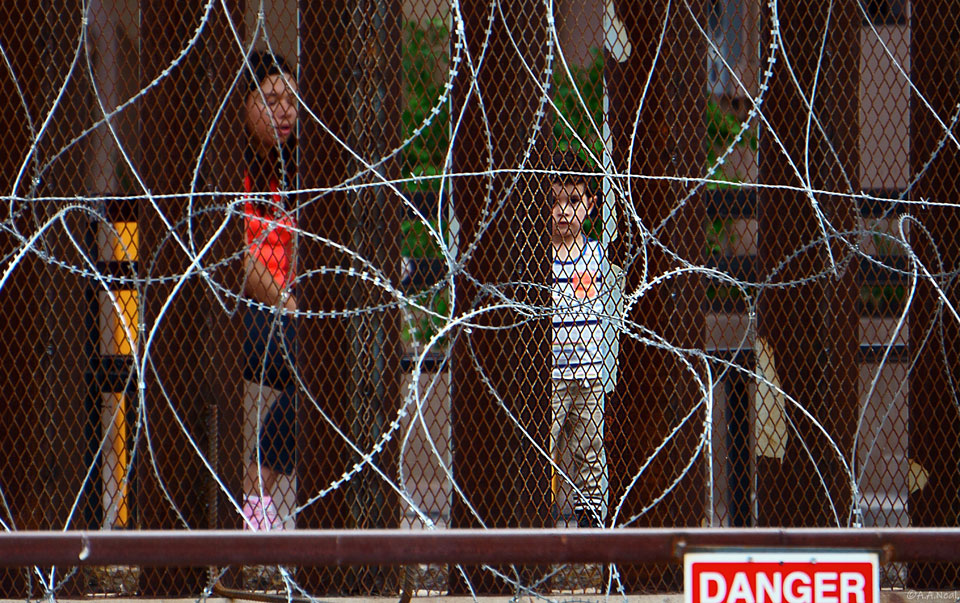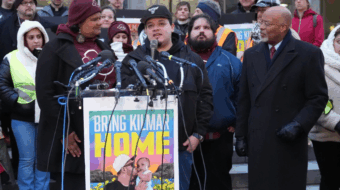
This article is part of the People’s World “On the Border Series,” which won a first place prize in the Best Series category at the 2020 Labor Media Awards, presented by the International Labor Communications Association.
People’s World correspondent Al Neal is in the field reporting from sites all along the U.S.-Mexico border. In his dispatches, you will get a view of the towns and people caught up in Trump’s “border crisis.” You will see the women, men, and children impacted by the administration’s immigration policies as well as U.S. foreign policy in Latin America. Other installments in the series can be read here.
It was the eyes.
The sorrowful, melancholic eyes of the little Mexican boy staring back at me through the cracks of the razor-wired wall as I stood opposite him and his mother, pausing briefly before taking another photo, that brought the humanitarian crisis happening at our southern border into clear focus.
This isn’t about politics, it’s about people.

The people devastated by American policies and interventions in Latin America, politicians’ need for approval ratings and votes, veiled racism in the form of “America First,” and the despot pulling the strings with his orange fingers back in Washington D.C. (as well as his many predecessors who wreaked havoc in the global south).
The child’s soul-piercing gaze broke away from mine and turned toward the two Customs and Border Patrol (CBP) SUVs quickly rolling in our direction.
“Ven aquí!” (Come here!),” yelled his mother over the sound of roaring engines, as he wandered a bit too far and too close to the wall.
As the patrol passed by, a beat-up, rusted van with a sign reading “Shuttle from Nogales, Mexico, to Tucson, Arizona” simultaneously came to a jolting stop on the other side. Several families began gathering around, including the boy and his mother.
My left ear only heard the excited Spanish chatter of families loading into the van, while my right ear heard mostly English.
If you closed your eyes, you wouldn’t be able to tell whether you were in the U.S. or Mexico—that, I suppose, is the inherent beauty of a border town.
The town(s) of Nogales, Ariz., and Nogales, Sonora, Mexico, lie 60 miles south-southwest of Tucson. It is Arizona’s largest international border community and is a major port of entry and international trade, connecting Mexico all the way up to Canada through the CANAMEX Corridor.

As I drove past Tucson on my way to the border, experiencing the dreaded June heatwave, the cityscape turned into a quiet, sparsely covered desert landscape—the rugged, reddish mountains a swift blur as the speedometer hit 80 mph.
The drive felt surreal. A strange anxiousness hung in the air as if I were driving toward an active combat zone.
The unexpected company of A-10 Thunderbolt II fighter jets, above and to the left of the highway, added to that palpable feeling. The Davis-Monthan Air Force Base was only five miles south-southeast of downtown Tucson.
And while I’m certain it was only a routine training exercise, for a moment it seemed as if those fighter pilots were preparing to encounter invaders at the front-line…our border crossing. It would fit with our warhawk president’s description of our border towns being “uncontrolled havens for enemy combatants.”
He continues carrying on his unholy crusade to dehumanize migrant refugees seeking asylum from the chaos we created in their homelands.

After 45 minutes, you see the highway signs change to both Spanish and English; the maximum and minimum speed signs go from miles-per-hour to kilometers-per-hour. Then, 20 minutes later, the shape of a venomous snake slithering through the hillsides comes into view—you have reached the U.S. border, and are seeing the dreaded steel and chain-link fence wall.
“Crucé el Rio Grande nadando – I swam across the Rio Grande / sin importarme dos reales – Without making a fuss / me echó la migra pa’ fuera – The border patrol threw me back out / y fui a caer a Nogales – And I landed in Nogales /entré por otra frontera – I entered by another border crossing / y que me habientan pa’ Juárez… – And then I was thrown out to Juarez…” —Los Mandados (La Migra) by Vicente Fernández
Nogales is a small town. Roughly 20 square miles. And like many desert towns, it is hot, arid, and dusty. The town is quite colorful. Bright pink, yellow, and red hues make up the color scheme for most of the town’s homes and storefronts.
It made the news earlier this year when Border Patrol busted a truck driver smuggling 254 pounds of fentanyl hidden in crates of cucumbers.
If it wasn’t for the drug bust publicity and moistureless, tan setting, Nogales would look like any small Midwest town.
Families went in and out of grocery, clothing, and electronic stores. Children played in the tiny, brownish green park in the center of town, some running off to hide rather than go to the dentist.
As the afternoon grew cloudy, families began making their way towards the pedestrian border crossing.
I walked with them, watching as they pulled out their paperwork, stopped to have “serious talks” with their kids, and prepared to make their way back home, or just a quick stopover for a visit with family on the other side.
CPB presence grew the closer we got to the wall, and everyone crossing the crosswalk made all efforts to avoid eye contact with officers—many of them making notes and taking photos while in their air-conditioned government SUVs.
At each streetlight, a sticker reading “U.S. Murder Patrol” was likely to be seen pasted to the pole.
The concertina wire that now sits atop the Nogales border wall was only put in place last year, and the presence of U.S. troops installing it was not welcomed.
“They should not be here,” said Nogales Sherriff Tony Estrada in November last year. “There is no invasion; this is not a war.” For many border residents, Trump’s plans to secure the border present a fundamental misunderstanding of life on the border and fail to deal with the humanitarian crisis taking place in Central America.
Today, the majority of families presenting themselves at the border crossing seeking asylum, or coming by cover of darkness, are from Central America. And they risk everything, even placing their trust in human smugglers (Coyotes) and various cartels, to lead them across, just to leave all the violence and corruption they’ve experienced behind.
So, what happens if CBP rounds them up?
“Sanctuary!”
Back in Tucson, there’s a Benedictine Monastery.
Where once it was filled with nuns, priests, and faithful Catholic lay people, today its spacious religious interior is filled with green, standard issue Army cots instead of pews.
Empty and owned by a Tucson developer since 2018, the monastery has been used by Casa Alitas, a Catholic charity, since January 2019, offering hope and warmth to Central American families after they’ve been detained by CBP. The church is their first stop after leaving the detention center.
“Yeah, families are usually dropped off at the monastery by ICE or sometimes Border Patrol,” said monastery volunteer RD (his full name will not be used for security reasons). “It takes them a little while to understand what’s going on when they’re dropped off; many are unsure of what’s going to happen.
“These refugee families are being sent to us after suffering a very hard trip followed by several days in detention, at least,” he continued.
Once inside, migrant families are led through a series of check-in stations, each person processed for their specific needs, and set up with a sponsor in the U.S. who can house them.

“We see a lot of families coming in from Guatemala and Honduras, and often they come to us very sick—low-grade fevers, colds, infections. We try to make sure that our entire local volunteer network supports them, either by cooking, cleaning, and more importantly, getting them the medical attention, they need,” RB said. “After a while, they realize they are in a safer place.”
Migrant families enter with hardships and but leave with fresh clothes, food, and water, and a constant hand throughout the asylum application process. Most still carry their trauma out with them, as well. Their stay at the monastery usually lasts about three days until they’re able to travel to their sponsor’s location.
“Pretty much every single person that comes through here is a parent with a child or a mom with multiple children, or sometimes it’s a couple with children. Many people have been hurt on the way in multiple ways by people who’ve violated trust or betrayed them or stolen from them,” said Kat Rodriguez, an intake coordinator at Casa Alitas. “All we can do is show them kindness and compassion.”
Sadly, the monastery’s doors will be closing at the end of July, and new sanctuary locations will have to be found. But, according to RB, it shouldn’t be too hard to find new spaces.
The entire city of Tucson, it seems, is committed to being a safe haven for migrants seeking asylum in their part of the southwest.
“We’re not really sure what’s going to happen, you never know what the border crossing numbers will be,” RD said. “But no matter what happens, we’re all human beings, we all struggle and feel pain, and those families coming over deserve to have people to help them.”










